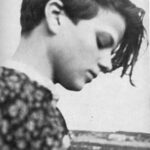While today, history books use the Spanish Civil War as a means of understanding how fascism overcame republican rule throughout Europe, until the final defeat of Nazi Germany in 1945, at the time many creative artists like Ernest Hemingway, who, one would think, would enthusiastically embrace anyone fighting against dictatorship, were torn about their loyalties and their understanding of the people involved. Proof is shown in a letter Hemingway wrote, after the fact: ” In stories about the [Spanish Civil] war I try to show all the different sides of it, taking it slowly and honestly and examining it from many sides — it is very complicated and difficult to write about truly — 1 would like to be able to write understandingly about both deserters and heroes, cowards and brave men, traitors and men who are not capable of being traitors. We learned a lot about all such people” (Solow 103).
What Hemingway did write during this period, among other articles and correspondence was perhaps his most complex novel, For Whom the Bell Tolls. He had always been a fan of things Spanish. After all, he was an aficionado of bull fighting, and had among his circle of acquaintances some of the leading toreros of the time, much of that fascination was captured in his novel, Death in the Afternoon. But Hemingway saw the Spanish Civil War as he saw many things Spanish, namely as a series of unexplainable contradictions. As Solow (2010) contends, ” In For Whom the Bell Tolls (1940), the fight against fascism,. pitted against love and individuality, emerges as a blunt necessity for which the central character pays the ultimate price — For Whom the Bell Tolls is an incitement to wage a particular war while hating war in general, a response that mirrors the author’s wrestling frame of mind. Hemingway’s own journey from an anti-political isolationist into a political advocate, from a pro-Loyalist subsequently disillusioned with elements of “the cause,” yet always steadfast in his anti-fascism- sheds light not only on Jordan’s fate, but on his creator’s narrative project and maturation as an artist” (108).
It seems pretty clear that one identifiable town which Hemingway’s characters talk about in For Whom the Bell Tolls is a city named Ronda: ” Ronda sits perched in the hills of southern Spain, halfway between Seville and. Malaga. Its dramatic setting, hanging on the cliffs above a river splitting the town in two, has inspired poets and artists for generations, most notably Rainier Maria Rilke — Although Hemingway does not mention the location of the massacre in For Whom the Bell Tolls, scholars have traditionally assumed that Ronda was the site of the peasant uprising” (Buckley, 50).
The problem with the novel is not its drama or its characters, all of which can be read and understood superficially. It is what lies underneath- the lack of understanding just what the Spanish Civil War meant to the people of Spain and what was to gruesomely follow with Hitler’s Blitzkriegs. “Robert Jordan attempts to realize his idealizations of a nation, a lover, and himself, despite the contradictions to be found in each. He is a study in commitment to noble action, albeit in pursuit of an unrealizable ideal, and he is a central element in the novel’s overall consideration of the conditions and consequences of approaching the unattainable. For Whom the Bell Tolls can be read as Robert Jordan’s heroic journey to perfect self-knowledge, culminating in his death — or as an ironic journey in which he gives his life for a culture that he idealizes but barely understands” (Link, 134). In essence very few of the foreigners who came to fight for what they believed was a just (if leftist) cause, truly understand the merits of their fight or its consequences.
One critic best sums up what one needs to learn from what is truly an outstanding, multi-layered novel of its time- and its timelessness: “Hemingway constructs at least three identifiable layers of discourse in For Whom the Bell Tolls. First, he offers a natural view juxtaposed against the events of war and creating a common dialogical ground between author and reader. second, he creates discursive space between characters to depict how wartime experiences are felt and understood among different individuals. Finally, Hemingway constructs Robert Jordan’s internal dialogue to depict a character grappling with the fundamental contradiction between the necessities of war and the value of human life” (Lester, 116).
Much as in Picasso’s famous Guernica, Hemingway depicts both the beauty and the horror, almost within one another, as the brutality and the sad inevitability of the Spanish Civil War engulfs landscape and characters.
References:
Buckley, Ramon: ” Revolution in Ronda: The facts in Hemingway’s
For Whom the Bell Tolls” The Hemingway Review
Fall 1997 . Vol. 17, Iss. 1; pg. 50
Lester, Jennifer: ” READING FOR WHOM THE BELL TOLLS
WITH BARTHES, BAKHTIN, AND SHAPIRO”
The Hemingway Review, Spring 2007 . Vol. 26, Iss. 2; pg. 116
Link, Alex: ” RABBIT AT THE RIVERSIDE: NAMES AND IMPOSSIBLE
CROSSINGS IN HEMINGWAY’S FOR WHOM THE BELL TOLLS”
Moscow: The Hemingway Review Fall 2009 . Vol. 29, Iss. 1
; pg. 135
Solow, Michael K.: ” A CLASH OF CERTAINTIES, OLD AND NEW:
FOR WHOM THE BELL TOLLS AND THE INNER WAR OF
ERNEST HEMINGWAY” Moscow: The Hemingway Review
Fall 2009 . Vol. 29, Iss. 1; pg. 103


